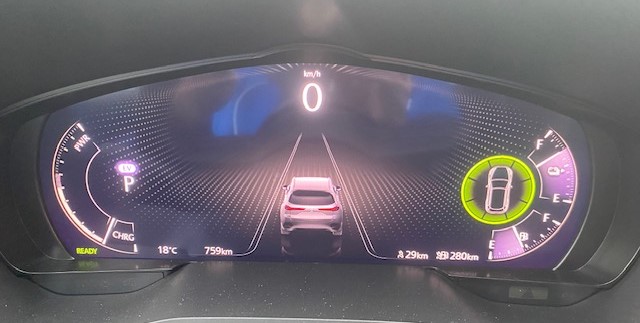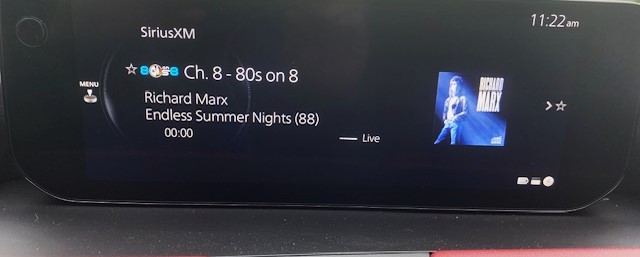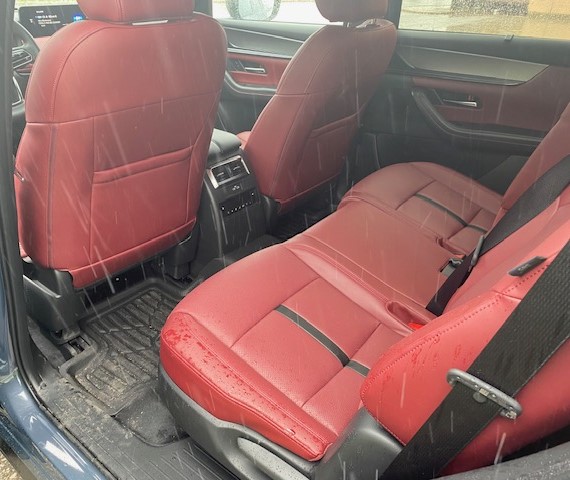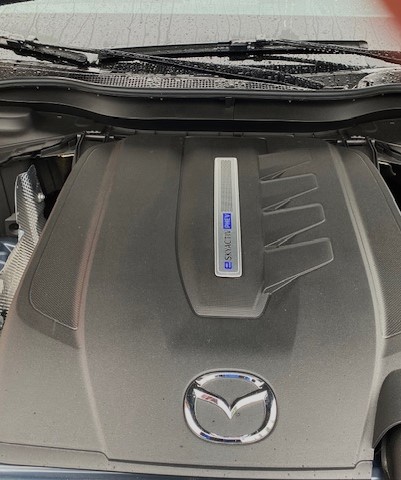
Black trim elements replace the chrome accents of the CX-90. Black blanking plates under the headlights seem pointless
History
The CX-70 is a two-row derivative of the CX-90 that went on sale a year ago. The wheelbase and overall length for both models are the same, so it is a bit of a mystery as to why they didn’t release the CX-70 as the CX-90 two-row. Creating a heavily modified variant as a separate model seems like a lot of effort for no real benefit. Like on the CX-90, two engines, an inline six turbo with a 48 volt mild hybrid system and a plug-in hybrid (PHEV) that combines the efforts of a 2.5L four and an electric motor, are available in the CX-70. The sole transmission offered is an eight-speed automatic that uses a wet clutch and no torque converter.
Model tested
All CX-70s feature two-row seating. The PHEV powertrain combines a normally-aspirated 2.5L four and a 62 kW electric motor to create 319 combined system horsepower, 369 lb-ft of torque and 42 kilometers of all-electric range. All-wheel drive is standard and power reaches the wheels via an eight-speed automatic transmission.
| Vehicle tested | 2024 Mazda CX-70 PHEV GT |
| Body Style | Two-row crossover vehicle |
| Engine | 2.5L naturally-aspirated four-cylinder engine and Plug-in hybrid system |
| Transmission | Eight-speed automatic |
| MSRP Spread | PHEV: $58,750 – $63,350 |
| Price as Tested | PHEV GT: $63,900 (includes Polymetal paint ($300), Garnet leather ($250) |
| NRCan combined fuel economy | 8.7L/100 km |
| Observed fuel economy | 6.9L/100 km |
Styling
The front of the CX-70 displays a very Mazda grille underlined by a black chinstrap element that become turn-signal-incorporating winglets that meet the headlights. Under the headlights are large, superfluous black inserts bearing an embossed pattern that echoes the grille. The chrome fillets on the front fascia, lower body and window frames on the CX-90 have been replaced by black accents. The side profile of the CX-70 is visually calm and uses shape rather than surface busyness to create a visual tension that is truly elegant. The shape of the car and its stance actually telegraph the fact that the car is built on a rear-wheel drive architecture. About the only styling miscue is the unnecessary black plastic plugs inserted into the upper front fenders. The tail of the CX-70 is as elegant and finely drawn as the rest of the vehicle. |

Crisp looking digital gauge package

The dashboard is visually spare but very elegant. Massive and tall centre console cuts into front occupant space

Wide and shallow infotainment screen
The cabin is very traditional and mostly elegant. The driver faces Mazda’s a large, configurable gauge package of impressive clarity. The climate control is operated by a plethora of physical buttons which are at the bottom of the dash centre stack. Fan speed, distribution and recirculation are all the same size and not that easy to distinguish from each other. The physical buttons are appreciated compared with the screen-based controls on many cars, but having the fan speed in a different colour or slightly different size than the other buttons would be useful. Temperature adjustments are handled by toggles for both front occupants, and there is an auto climate toggle on the driver’s side. A medium size shallow screen is propped up on the dash. The low height of the screen restricts the view when reversing. The infotainment system is controlled by a large rotary control mounted on the centre console. The wheel is surrounded by four buttons which access the various functions. The on-off volume knob for the audio system is located to the right of the buttons. Reviews on the roto-wheel system are mixed, but some prefer the apparatus over a touch screen as it is easier to manipulate while driving. The screen can only activated by touch when hooked up to the iOS-Android cellphone interface. The sound from the Bose-branded audio system is unimpressive. Though the glazed area of the dual-panel sunroof is modestly large, the actual opening part of the sunroof is miniscule. In addition, the electrically-driven sunblind must be opened all the way to the rear before the actual opening part of the roof is used. Tedious.

Physical controls for the HVAC system are welcome but the buttons for fan speed should be a different size or colour to be more recognizable

The Park position on the shift quadrant is oddly, to the left of the directional gears. Printed pattern on faux allow trim is not to all tastes
The driver’s door window switch panel and the interior door handle are awkwardly placed, which is odd, as there is lots of acreage on the door to place things more appropriately. There is a massively wide and tall centre console, way beyond what is necessary, which reduces space for front occupants — disappointing in a massive vehicle. There are two cupholders to the right of the shifter; they’re a stretch for the driver. The shifter is very odd. Instead of being at the top of the PRNDL, Park is off to the left, with the rest of the PRNDL being on its own plain. There is a medium-size open bin in front of the shifter, which has a wireless cellphone charging pad. The front door trims are punctuated by large door bins but the storage bin under the centre console armrest is tiny. The cabin trim is generally attractive, with the two-tone red and black colour Nappa leather on our tester being particularly elegant. The expansive faux alloy-look trim panels on the doors and centre console bear a painted pattern that looks busy and is not to all tastes.
As in a number of other Mazdas, the seats of the CX-70 are, on first meeting, very, very firm. That said, the occupants and the seats somehow accommodate to one another and the seats end up being acceptably comfortable after a few days. The driver’s seat is multi-adjustable. The rear bench seat is more comfortable than the front seats and legroom is impressive.
Cargo space, unimpeded by a third-row seat and the space the seat would take up when folded, is vast, but total capacity with all but the front seats folded, is only 31 litres more than the three-row CX-90.

Rear passengers are pampered with a comfortable seat, copious legroom and rear climate controls
Performance

2.5L inline four is twinned with an electric motor mounted between the engine and transmission
The PHEV powertrain mates a normally-aspirated 2.5L four-cylinder engine, a hybrid drive system and a 17.8 kWh battery pack. Combined horsepower is rated at 319 horsepower on regular fuel and 369 lb.ft. of torque. Using a level 2 charger, the battery pack can be charged from 20 to 80 percent in 1.3 hours. Mazda claim an all-electric range of 42 kilometers. Power reaches all wheels via an eight-speed automatic transmission with no torque converter. The electric motor for the hybrid system is mounted between the engine and the transmission.
In terms of refinement, the CX-70 PHEV is two cars, depending on whether it is running in it PHEV mode or in regular hybrid mode. With the PHEV battery pack engaged, the CX-70 is impressively refined. However, once the battery pack is expended and the vehicle is operating in its regular hybrid (HEV) mode, the situation changes. The 2.5L four cylinder engine and HEV system deliver strong performance but the noise from the engine without the battery pack engaged is too intrusive for what is a very expensive vehicle. If test driving the CX-70, it is recommended to burn through the PHEV battery pack to experience what will be the sound track heard during the majority of driving.
While noise is an issue, there are no reservations about performance, which is impressive. The CX-70 accelerates with vigour whether the battery pack is engaged or not. Linking a hybrid powertrain with a conventional transmission is rare but the two work harmoniously.
Using the PHEV battery pack as much as possible, the observed fuel economy of 6.9L/100 kilometers is astonishing considering the performance and sheer girth of the CX-70 PHEV.
Steering is nicely weighted, precise and very quick, perhaps too quick. There is little free play at its centre position, making the vehicle seem a bit nervous on the highway.
The ride of the CX-70 PHEV is, for a large vehicle built on a long wheelbase, distressingly turbulent. Passengers universally expressed negative comments on how stiff the CX-70’s ride is. No doubt the ride is undermined by 275/45/R21 tires, which are more suited to a high performance car than a luxury family bus. Altered suspension settings and more suitable tires would no doubt improve ride quality.
Handling, however, is very steady but the vehicle feels heavy and cumbersome at all times. Certainly the handling does not compensate for the poor ride.
Braking is strong enough but but they feel grabby and hard to modulate.
The eight-speed automatic transmission in the six-cylinder CX-90 last year could be jerky in some conditions. The operation of the same transmission in the CX-70 PHEV cannot be criticized.
Pricing
The well-equipped $58,750 GS-L is the base model of the CX-70 PHEV lineup. Moving up to the GT adds a dual-panel sunroof, Nappa-processed leather seating, a leather covered dashboard, hands free tailgate operation, ventilated front seats, heated rear seats, a head up display system, Bose-branded audio, a power front passenger seat, rear door sunshades, adaptive headlamps, a wireless iOS-Android cellphone interface, the Alexa audio concierge, an auto-dim driver’s door mirror, power-fold door mirrors, navigation, garage door opener, 21 inch wheels (a negative feature for ride quality) and a number of minor features, at a bargain price. The CX-70 GT PHEV is priced only $1000 less than the CX-90 GT PHEV.

The CX-70 displays a spare elegance
Conclusion
The CX-90-CX-70 concept, a large CUV based on a rear-wheel drive architecture, is intriguing. On paper, the vehicle holds great promise, but the combination of the elements and the choices made by Mazda undermine the fundamental excellence of the CX-70 (and the related CX-90). Inside, the massive and wide centre console reduces front occupant space to an annoying degree for such a massive vehicle. Also, some trim choices, like the printed pattern on faux the alloy trim panels, are underwhelming. On the road, the steering lacks a stable centre point and feels a bit nervous on the highway and the ride is hampered by the odd choice of sports car-like 275/45/21 tires and overly stiff suspension settings. Refinement, once the PHEV power pack has been depleted, is disappointing, especially for what is a luxury-priced vehicle. Given that it has been a year since the CX-90 has been released, it is disappointing that Mazda has not addressed the negative aspects of that vehicle before they released the CX-70. Hopefully the faults of the CX-70 will be addressed when the car is facelifted in a few years.
